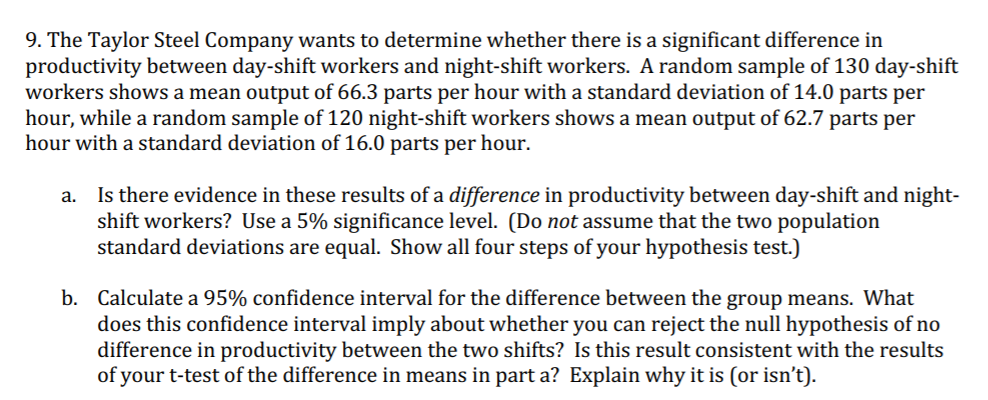9. The Taylor Steel Company wants to determine whether there is a significant difference in productivity between day-shift workers and night-shift workers. A random sample of 130 day-sh workers shows a mean output of 66.3 parts per hour with a standard deviation of 14.0 parts per hour, while a random sample of 120 night-shift workers shows a mean output of 62.7 parts per hour with a standard deviation of 16.0 parts per hour. a. Is there evidence in these results of a difference in productivity between day-shift and nigl shift workers? Use a 5% significance level. (Do not assume that the two population standard deviations are equal. Show all four steps of your hypothesis test.) b. Calculate a 95% confidence interval for the difference between the group means. What does this confidence interval imply about whether you can reject the null hypothesis of no difference in productivity between the two shifts? Is this result consistent with the result of your t-test of the difference in means in part a? Explain why it is (or isn’t).
9. The Taylor Steel Company wants to determine whether there is a significant difference in productivity between day-shift workers and night-shift workers. A random sample of 130 day-sh workers shows a mean output of 66.3 parts per hour with a standard deviation of 14.0 parts per hour, while a random sample of 120 night-shift workers shows a mean output of 62.7 parts per hour with a standard deviation of 16.0 parts per hour. a. Is there evidence in these results of a difference in productivity between day-shift and nigl shift workers? Use a 5% significance level. (Do not assume that the two population standard deviations are equal. Show all four steps of your hypothesis test.) b. Calculate a 95% confidence interval for the difference between the group means. What does this confidence interval imply about whether you can reject the null hypothesis of no difference in productivity between the two shifts? Is this result consistent with the result of your t-test of the difference in means in part a? Explain why it is (or isn’t).
Glencoe Algebra 1, Student Edition, 9780079039897, 0079039898, 2018
18th Edition
ISBN:9780079039897
Author:Carter
Publisher:Carter
Chapter10: Statistics
Section10.4: Distributions Of Data
Problem 19PFA
Related questions
Question

Transcribed Image Text:9. The Taylor Steel Company wants to determine whether there is a significant difference in
productivity between day-shift workers and night-shift workers. A random sample of 130 day-shift
workers shows a mean output of 66.3 parts per hour with a standard deviation of 14.0 parts per
hour, while a random sample of 120 night-shift workers shows a mean output of 62.7 parts per
hour with a standard deviation of 16.0 parts per hour.
a. Is there evidence in these results of a difference in productivity between day-shift and night-
shift workers? Use a 5% significance level. (Do not assume that the two population
standard deviations are equal. Show all four steps of your hypothesis test.)
b. Calculate a 95% confidence interval for the difference between the group means. What
does this confidence interval imply about whether you can reject the null hypothesis of no
difference in productivity between the two shifts? Is this result consistent with the results
of your t-test of the difference in means in part a? Explain why it is (or isn’t).
Expert Solution
This question has been solved!
Explore an expertly crafted, step-by-step solution for a thorough understanding of key concepts.
This is a popular solution!
Trending now
This is a popular solution!
Step by step
Solved in 2 steps

Recommended textbooks for you

Glencoe Algebra 1, Student Edition, 9780079039897…
Algebra
ISBN:
9780079039897
Author:
Carter
Publisher:
McGraw Hill

Glencoe Algebra 1, Student Edition, 9780079039897…
Algebra
ISBN:
9780079039897
Author:
Carter
Publisher:
McGraw Hill